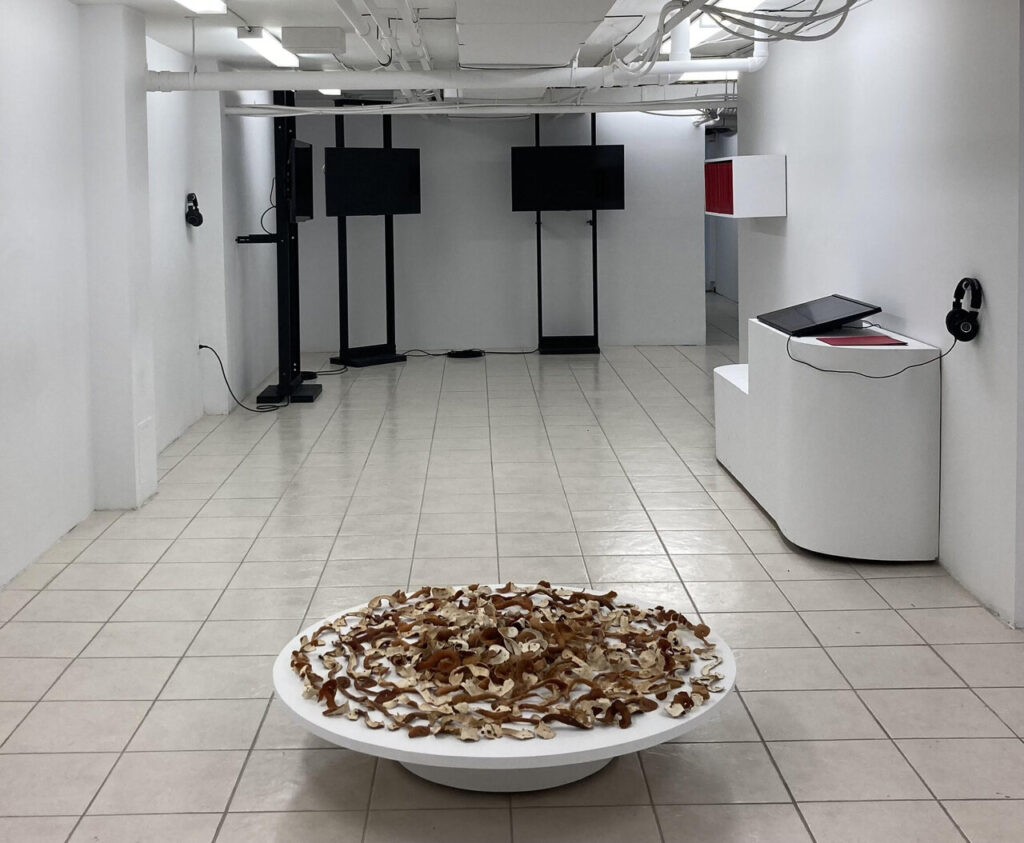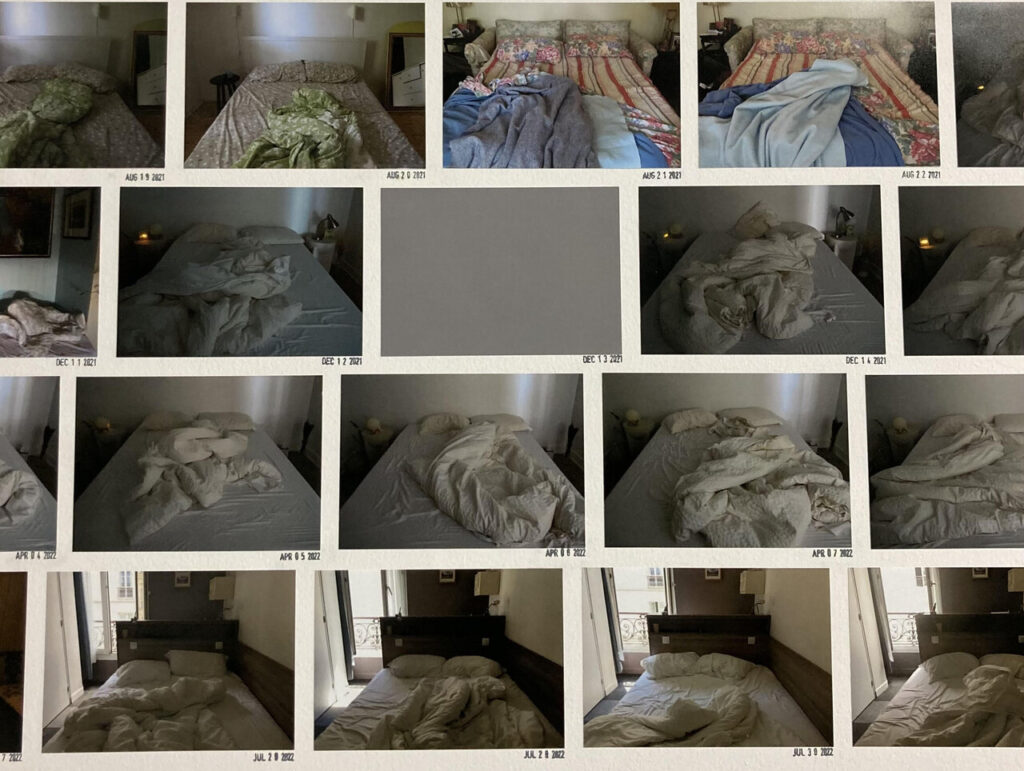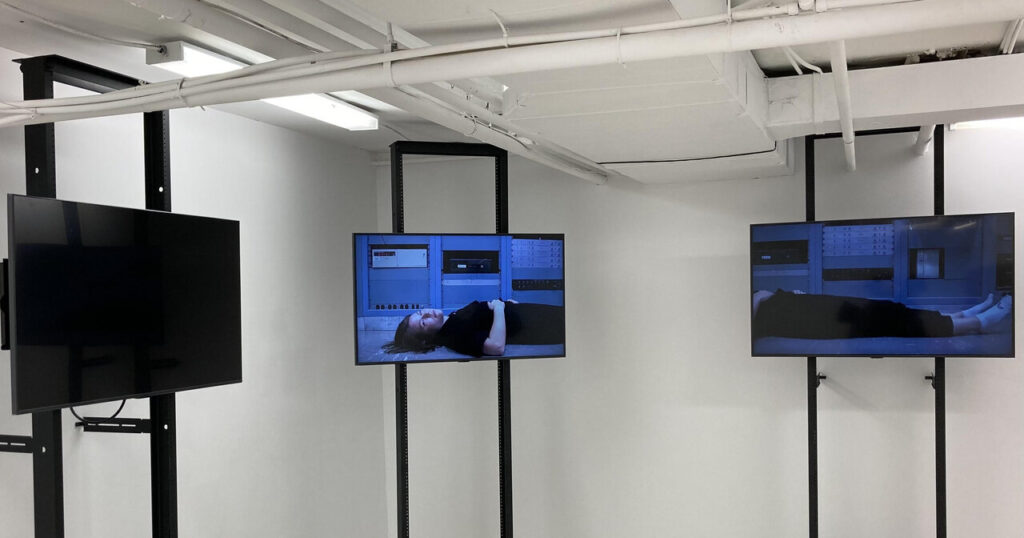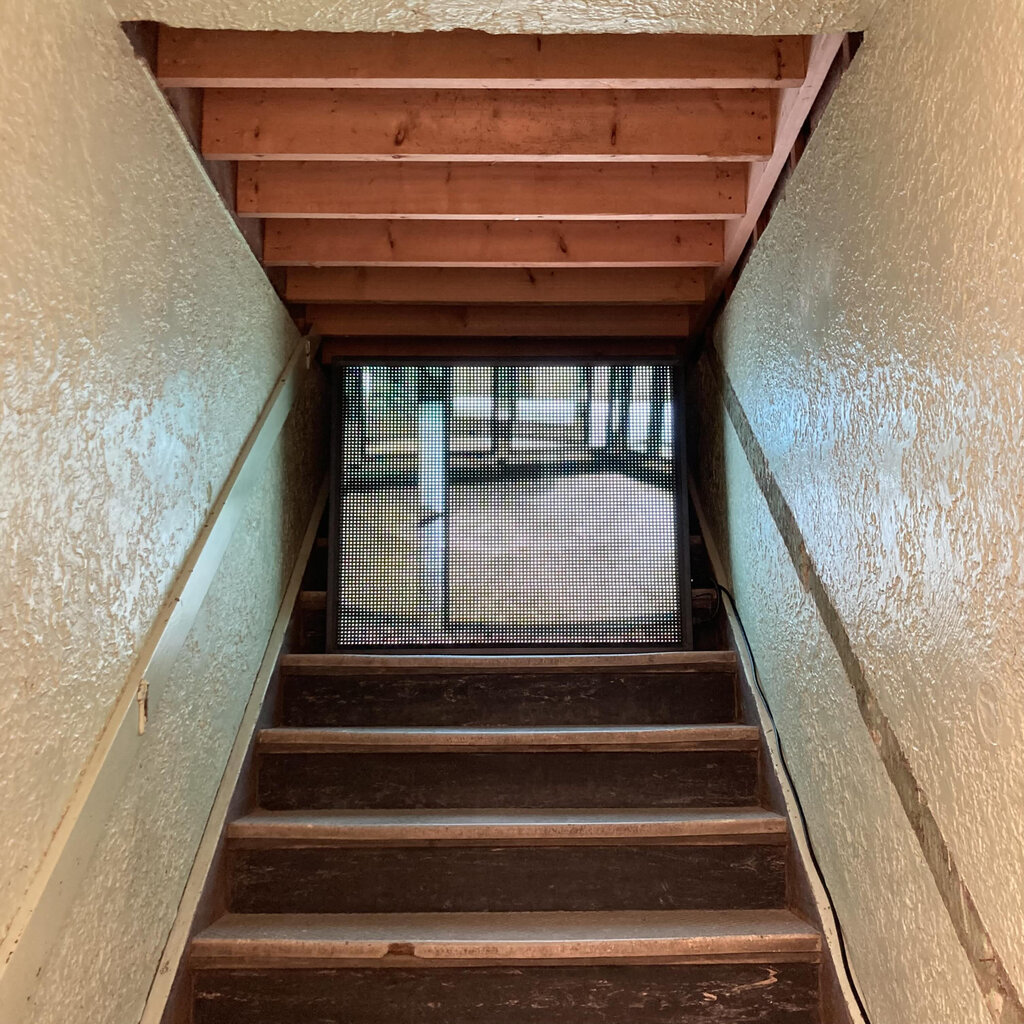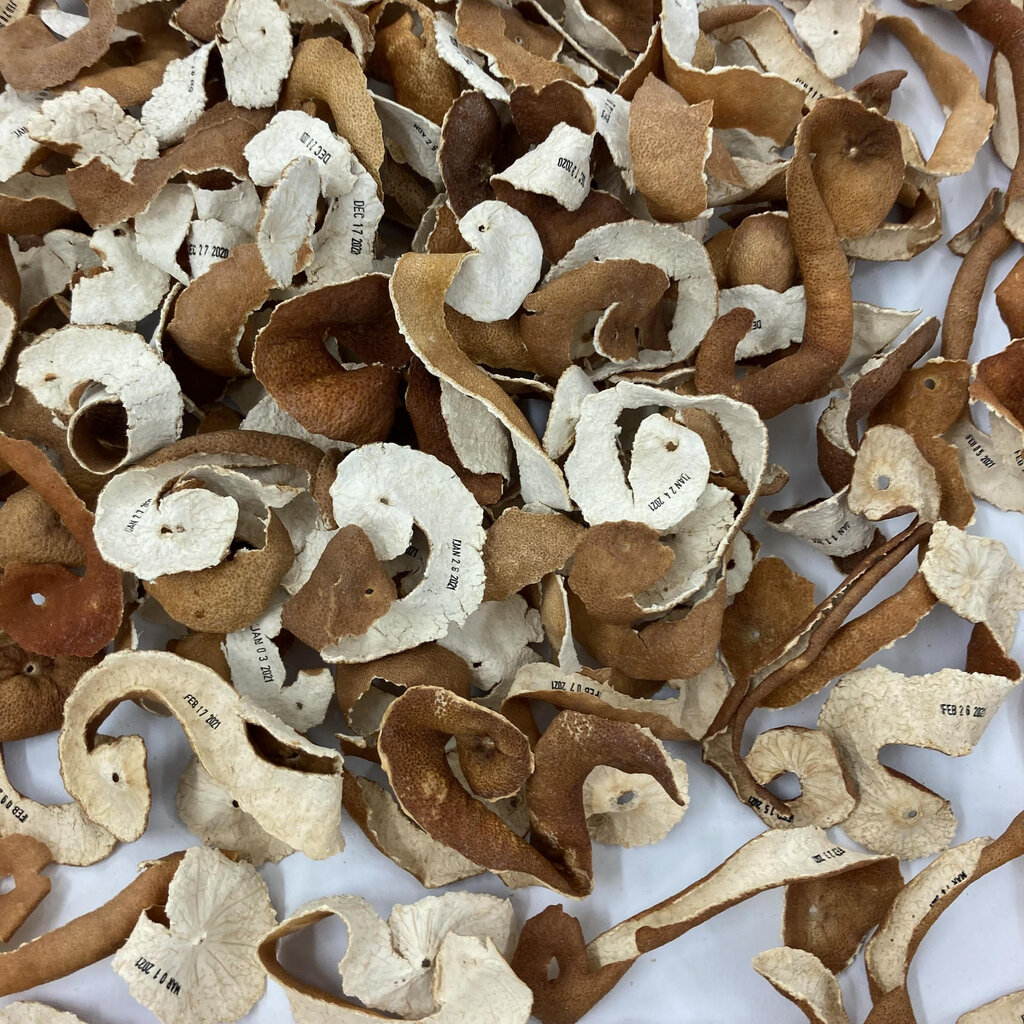The theme of repetition, time, and disruptions in rhythm are consistent throughout the exhibition the hole fits the worm, but only as it moves, at the plumb gallery. The exhibition consists of works by Toronto-based artists Ellen Bleiwas and Emily DiCarlo, curated by and in collaboration with Justine Kohleal. The show explores how we relate to time within and outside of capitalist systems, considering productivity and its counterpart of doing nothing.
Installation view of the hole fits the worm, but only as it moves, 2023
Upon viewing Ellen Bleiwas’ bed series Got Up (2021-2022), I immediately thought of Ling Ma’s novel Severance: “To live in a city is to take part in and to propagate its impossible systems. To wake up. To go to work in the morning. It is also to take pleasure in those systems because, otherwise, who could repeat the same routines, year in, year out?”. I contemplated the way in which routine factors into our existence and the constancy of submitting ourselves to the day. While there may be changes to the details, every day of our lives commences with our wake. Bleiwas successfully captures the sentiment of repetition and waking to repeat in Got Up. Each photograph holds a bed as the subject, adorned with pillows, duvets, and sheets. The linens are strewn about as if someone had just stirred and risen from rest. The consecutive days are documented with the date printed on the wall external to the photograph. Upon closer examination, there are days in which the bed changes, or there is an absence of documentation and instead a grey block is provided in lieu. The grey blocks and differences in bedroom subject matter give variety to the days of rest, a different site to which we return. Converse from sites of rest are sites of labour, though the two may blur. DiCarlo manages to combine the visuals of both in The Propagation of Uncertainty (2020).
Ellen Bleiwas, Got Up, detail view, 2021-2022
Travelling down the hallway towards a speaker (unfortunately missing the window for the announcements for DiCarlo’s Talking Clock Choir [2022]) I met three televisions and a pair of headphones from DiCarlo’s The Propagation of Uncertainty. The video begins with an introduction to the space of an archive, the National Research Council of Canada, with a pulsating hum and the face of a clock. There is a note stating ‘CALIBRATION IN PROCESS’ visible among the glimpses at different forms of equipment: binders, office phones, cabinets with a medley of wires, and stereo systems. In the auditory background is a voice stating “NRC / Eastern Standard Time” followed by the changing hours, minutes, and seconds repeating as time moves forward. The sound is ongoing featuring an automated recording of a woman’s voice in French, marking the official languages. There is a stream of automated recordings in waves, fostering the experience of being overwhelmed. As the video continues there is a woman lying supine, her breathing visible as she rests still. Her figure gradually shifts from the leftmost screen, then settling, then moves across the remaining two screens, pausing mid-thigh until the video restarts. The inundation of sounds and visuals associated with information collection and retention emphasizes the overstimulation that comes with undertaking work. There is so much to know, and so much we do not know to know.
Emily DiCarlo, The Propagation of Uncertainty, 2020
Towards the back of the gallery is Bleiwas’, DiCarlo’s, and Kohleal’s Prompt (2023-ongoing), a rolodex holding (presumably) tasks to complete yet they cannot be accessed. This is a mirror to the reality of knowing that there is always more to do, though exactly what is to be done is not always clear, despite expectations. The deluge of information and labour can leave one inert as time passes, in a loop of attempting to recharge to ready again.
Ellen Bleiwas, Emily DiCarlo, and Justine Kohleal, Prompt, 2023-ongoing
The idea of productivity and the need for rest can be felt in the surrounding works as well, such as DiCarlo’s Circular T: A Collection of Uncertainties (2020). There are twenty-two carmine binders tucked in a shelf diagonally above the plinth displaying a screen, headphones, and folder. The audio is a voice reading a transmission report text aloud, findings from examinations to improve employee productivity and harnessing energy reserves. The work brings up the question: is rest a disruption to the rhythm of labour, or is it the inverse? Is labour not the syncopation to the rhythm of rest, of life? Though it may be clear that optimal productivity is not worth more in contrast to an optimal life, living under capitalism means it is not a choice we can make as we have to survive. The notion of striving to do more than survive can be recognized in Prompt, comprised of business cards with statements to encourage patrons to take time and reflect upon doing nothing. The ten sets of cards vary with their texts, each carrying the sentiment that doing nothing is a worthwhile and necessary use of time. The cards accompany the rolodex seated on a plinth, and are a fitting segue to or from Throat (2023), a close-up view of a revolving door on an LED matrix display. The echo of “listen / a slow revolving door breathes” from the cards plays out in the mind’s eye.
Ellen Bleiwas, Emily DiCarlo, and Justine Kohleal, Throat, 2023
Making time to recalibrate and catch your breath is critical and imperative for one’s health. Taking pause is at the foundation of Bleiwas’ Peel (2020-2021), a spiraling mound of rust, clay, and burnt orange. The work consists of multiple clementine peels, undone in a singular piece often in the shape of an ’s’. The gesture of peeling a clementine in one motion can be imagined, a purposeful slow act prior to enjoying a nutrient-rich treat. Fruit takes time to grow, so why not take time to enjoy? Within the inner layer of the rinds are printed dates, reflecting daily consumption and reminding viewers to do the same to nourish their body.
Ellen Bleiwas, Peel, detail view, 2020-2021
On that same note of taking care of the self is Bleiwas’ Rip (2020-2022), moving towards hygiene as opposed to nutritional nourishment. Rip is a fleet of unused toilet paper sheets, serving as a material sample from each day with the date noted accordingly. Though they appear uniform, the distinct perforations and thickness can be recognized upon closer view. The differences in toilet paper reflects the fact that the way we address our needs shifts based on what is available and what one can afford. At a time when toilet paper was a scarce commodity, how can one be loyal to a brand— and why would they? Capitalism rewards loyalty through marketed pride, points, and bonus items, but when that loyalty does not exist the market variety is salient. Rip showcases such a variety, identifiable by the ridges, waves, and concentric circles. The correlation between how we care for ourselves based on what can be afforded or obtained is readily apparent, in this work and throughout the hole fits the worm, but only as it moves.
While we (the worms) can adapt to the hole, or our environment broadly, this exhibition pushes inner reflection towards how we respond to our surroundings and our existence. Though not easily done, why are we adapting to our infrastructure and capitalist systems? Should the infrastructure and systems not be accessible and supportive for us, not for our suffering but to thrive?
Text and photo: Rashana Youtzy
*Exhibition information: the hole fits the worm, but only as it moves, November 3 – December 3, 2023, the plumb gallery, 1655 Dufferin Street, Toronto. Gallery hours: Sat & Sun 2 – 5 pm or by appointment.

